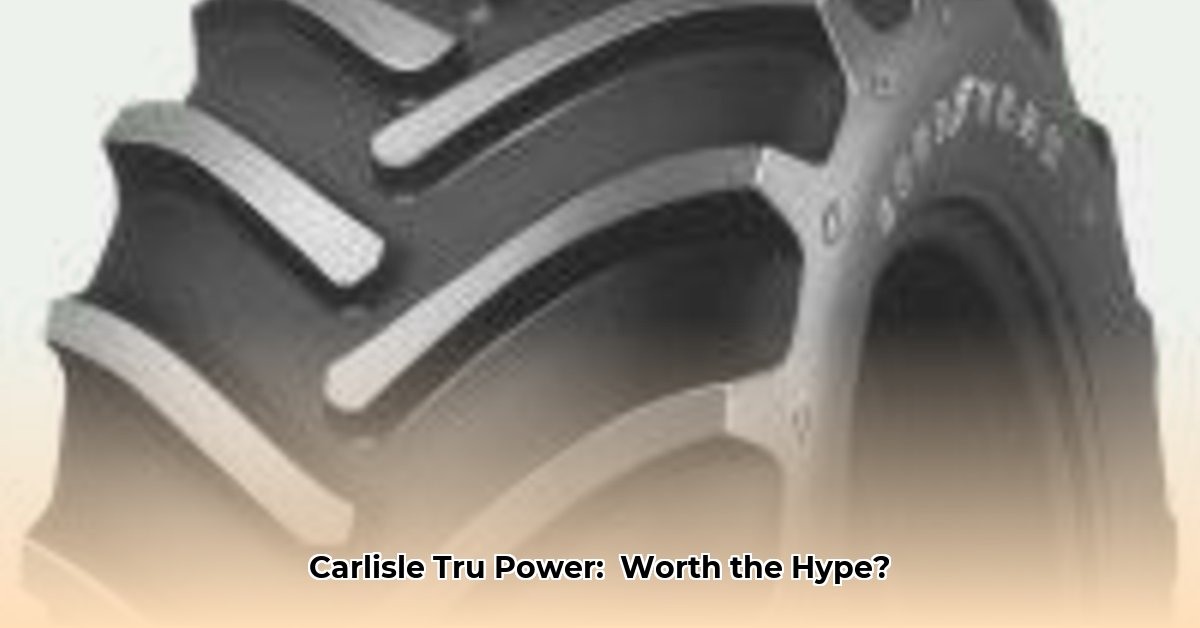
Choosing the right tractor tires significantly impacts operational efficiency and long-term costs. This technical review analyzes the Carlisle Tru Power 29x12.50-15 tire, examining its specifications, performance characteristics (where data permits), limitations, and associated risks. The review aims to provide actionable intelligence for farmers, distributors, and manufacturers. For further information on tire maintenance, see this guide.
Carlisle Tru Power 29x12.50-15: Tire Specifications and Construction
The Carlisle Tru Power 29x12.50-15 is a bias-ply agricultural tire. Bias-ply construction (where tire plies run diagonally) offers inherent robustness and relatively low initial cost. This tire boasts a 6-ply rating, suggesting high load capacity (claimed at 1650 pounds). The 29-inch diameter and 12.5-inch section width are common sizes for many tractors. A tread depth of 9/32" indicates moderate wear resistance, though long-term durability requires further verification. The tire features a directional tread pattern designed to optimize traction in challenging conditions. [Insert image of Carlisle Tru Power tire with close-up of tread pattern here]. [Insert cutaway diagram illustrating bias-ply construction here]. A speed rating of H (up to 130 mph) is largely irrelevant for typical agricultural applications. The tire's origin in China is a factor to consider regarding supply chain dynamics and international trade implications. How might this affect the long-term availability of this tire?
Performance Assessment: Data Gaps and Interpretations
While the stated specifications provide a foundational understanding, comprehensive performance data is currently limited. Crucial data points on fuel efficiency (liters/hectare or gallons/acre), wear rate (months or hours of operation to significant wear), and puncture resistance are unavailable. This lack of data hinders direct comparisons with competitor products. A comparative analysis highlighting key performance differences (even with incomplete data) would greatly improve the review’s value. [Include comparative table if data becomes available]. Further field testing and independent verification are essential to fully characterize the tire's performance across various soil types and operating conditions. What independent tests would provide the most comprehensive performance evaluation?
Actionable Intelligence for Key Stakeholders
This section outlines specific actions and strategies for different stakeholder groups:
1. Farmers and Agricultural Businesses:
- Short-Term Actions: Conduct rigorous field tests under representative conditions. Meticulously track fuel consumption, tire wear (using a tread depth gauge), and any instances of punctures or unusual wear. Maintain accurate records for future analysis.
- Long-Term Strategy: Calculate the total cost of ownership (TCO), incorporating initial purchase price, fuel consumption, tire lifespan, and maintenance expenses. Consider the long-term implications of choosing bias-ply versus radial tires based on your specific needs and operational profile. Compare TCO with radial alternatives using both direct and indirect cost calculations.
2. Tire Distributors:
- Immediate Actions: Closely monitor market demand for bias-ply versus radial tires. Maintain optimal inventory levels based on actual sales data, adjusting stock as needed.
- Future Planning: Diversify tire supplier relationships to mitigate supply chain risks. Identify and pursue niche agricultural markets where bias-ply tires may possess advantages. Solicit feedback from farmers to refine product offerings and optimize inventory.
3. Carlisle/Carlstar (Manufacturer):
- Immediate Actions: Invest in independent testing and verification programs to obtain quantitative performance data. Make verified data readily accessible to potential customers.
- Long-Term Goals: Develop a comprehensive digital marketing strategy that transparently presents performance data and highlights the tire's key features and benefits. Explore market diversification strategies catering to specific niche customer requirements.
Risk Assessment and Mitigation Strategies
The following matrix summarizes potential risks associated with the Carlisle Tru Power 29x12.50-15 and outlines corresponding mitigation strategies:
| Risk Factor | Likelihood | Impact | Mitigation Strategy |
|---|---|---|---|
| Premature Tire Failure | Moderate | High | Implement rigorous pre-use tire inspection protocols; maintain correct inflation pressure; use appropriate tires for specific applications. |
| Supply Chain Disruption | Moderate | Moderate | Diversify sourcing; build strategic inventory; develop strong relationships with multiple suppliers. |
| Insufficient Performance Data | High | Moderate | Commission independent, third-party testing; develop internal data collection systems; publicly publish verified performance data. |
| Increased Fuel Consumption | High | Moderate | Clearly communicate fuel consumption trade-offs compared to radial alternatives; conduct comparative fuel efficiency studies. |
Regulatory Compliance
It is imperative that users ensure the Carlisle Tru Power 29x12.50-15 complies with all applicable safety and regulatory standards in their region before use. This review does not independently verify compliance.
Conclusion
This review provides an initial assessment of the Carlisle Tru Power 29x12.50-15 tire based on available information. Significant data gaps remain, emphasizing the need for further independent testing and data collection to provide a comprehensive evaluation. The ultimate decision regarding suitability hinges on specific operational needs, long-term cost analysis, and careful consideration of the trade-offs between bias-ply and radial tire technologies.